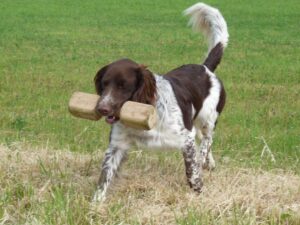Dog Nicknames are short, evocative words that do not include the names of people, cities, countries, or nationalities. The conditional reflex to the nickname develops during daily dog-handling, but is more common when a dog is walked or fed. The trainer (the owner) calls the dog and tells him the nickname. He then gives the dog food or treats. The dog will pay more attention to the nickname as it begins to walk and learn techniques to train. It is not acceptable to use a frightening tone of voice or to incite fear. Trainer faults and the implications
1. A mispronunciation of nickname, especially when it is sounded menacing.
2. It is not necessary to repeatedly repeat a nick-name. This can hinder the formation of conditional reflexes on other commands.
Training for Special Equipment

Training is usually done at an early age for muzzle, collar, and leash dogs. They are taught to be calm around the collar. The trainer will then give the dog a treat and allow them to sniff the collar. After stroking the dog with his hands, the trainer wraps the collar around the neck of the dog and holds the ends in play to distract it. The collar can be removed if the dog is having trouble. The exercise is then repeated. The collar should be left on for longer periods of time. The soft collar can then be replaced with the normal. It is important to make sure that the puppies do not chew each other’s collars if there are several of them. After training the dog to calmly respond to the collar, it is time to train the dog to use a leash. The trainer strokes the dog and then attaches the leash. It is important to play a game with your dog or to keep it from reacting to the leash. Dog management in areas where there are trees, shrubs, or other obstructions is a delicate task. Short and long leashes are used for dog management.
The command, “Come!” The command “Come!”

and the gesture: lowering your left hand to your thighbone.Reinforcement – Give the treat, stroke and sometimes tighten your leash. It is started from the day the dog starts walking. Dog training begins with food. Training is conducted in an area that has the fewest distractions. The dog should be hungry, or half-starved, and be able to walk well. This is how the exercise is done. The trainer calls the dog’s name, draws attention to the meat in his left hand, and then commands him to “Come!” The thumb keeps the treat in the hand. The hand should move freely at first. Next, raise the left hand and bring it up to shoulder level. Gradually, the raised hand will become a signal for the dog to be given a treat. The trainer should not allow the dog to come too slow or sluggishly. This exercise should be repeated 10-15 times during a two-hour training session. If the dog doesn’t respond to the treatment, the trainer will draw attention to his behavior by tying the leash and gently stroking the dog.
The following complications can be introduced when the dog responds to the command “Come”, and then runs quickly and interestedly towards the trainer, using a long-distance leash.
* Separate command and gesture control of the dog;
* Training to sit in front of the trainer after getting closer.
* a gradual increase in sitting in front of the trainer as it gets closer;
* Calling the dog from any position; training the dog to sit next to the left trainer’s feet after being in a sit-ting position before the trainer.
* Training for success in the presence of distractions
* Control of the dog with or without a leash
* Calling the dog in various positions by the trainer: standing, sitting, or lying down, motion from behind a cover, etc.
Reinforcement: stroking, jerking, leash, and lashing. From the very beginning of training, the movement is applied. Contrast the basic training method. The initial exercises are done on a flat surface and in simpler conditions. The trainer attaches a short leash to his dog’s collar and wraps its free end around his right arm. The trainer then holds the leash in his left hand, at a distance between 20-25 cm and the collar. He takes the mid-leash in his right hand. After initiating the movement, the trainer gives the command “Heel” which causes the leash to jerk along the dog’s body for 0.5-2 seconds. The trainer should start by walking the dog in a slow, controlled manner. This will allow the dog to become more comfortable with the trainer. Once the dog is properly positioned, close to the left foot of its trainer, the last encouragement will be given by the treat, stroking. Each command “Heel”, which drowns the dog’s conditional reflex, is accompanied with a jerk on the leash. If the dog’s running speed left hand. After 1-2 seconds, he gives the command “Heel” then jerks the leash. The command and the jerk can be used to support this gesture, but it must not become a conditional stimulus. In the future, the trainer will only use the jerk by the leash. You can consolidate your skill by correctly executing the command or gesture, as well as reinforce it with a treat, stroking, or unacted command.
Command “Walk”

In any situation, the ability to change into the “stand-at-ease” position is essential. This skill can be used in training, working or any other situations when the dog requires rest. Gesture: To point the right (or left) hand in the direction of the dog’s movement. Application markers — signs of fatigue in nervous, muscular, and other systems that activate the reflex to freedom. This command is learned from the beginning of training. It is to be practiced throughout the training course. Verbal commands and gestures are used to train the reflex. This is how the exercise should be done. The trainer holds the dog’s side and pulls the leash towards his collar. The trainer gives the dog the command to walk.
He should then run fast, running for 15-30 feet while continuing the walk command. After 2-3 seconds, the hand is directed away (gesture), and is then placed on the hip. The trainer allows the dog to run on the leash after the short walk. He calls the dog again after 1-2 minutes, treats it and then re- peats the exercise. The following rules must be followed when per- forming the exercise: the initial walking should be done on a long leash. Loud commands and abrupt snapping should not be used. While walking, the dog should always be within sight of the trainer.
The following complications can gradually be introduced:
* Control of the dog discreetly by command or gesture
* Walking with the following steps:
* Passing the dog to the stand at ease from any position, including sitting, standing, or being down. •
* Walking close to different stimuli and accounting for the dog’s behavior;
* Alternate walking in both the absence and presence of stimuli. Walking unassisted should be avoided.
* Improvement of walking in a zigzag pattern upon command or gesture
This skill is considered perfect when the canine moves quickly in the direction of the walk command or in gesture. Possible mistakes by the trainer and other conse- quences
1. A choke chain is used to provide stand-at-ease for the dog. The leash should be short.
2. To give commands with an excessively high tone and leash snatching while walking
3. Stamina development is hindered by frequent standing-at-ease in sitting, lying down, and remaining.
4. Dogs who are unable to walk on leashes can become disruptive and lose their ability to be disciplined.
